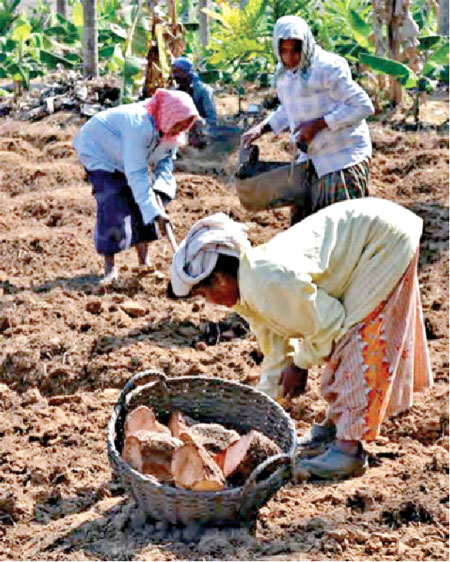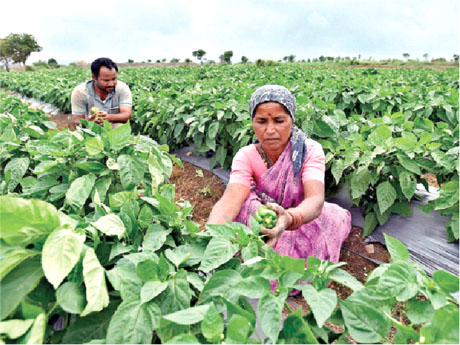Endowed with crop diversity, Bharat holds the key to solve the problem of global hunger and Malnutrition
India has survived a series of assaults on its rich crop diversity. The British Government first tried to destroy India’s crop diversity by introducing mono crop cultivation. Tea, coffee, cotton, sugarcane and indigo wiped out many exotic climate friendly native crops. Consequently, India faced a famine-type situation after Independence and was compelled to allow the high yielding wheat and rice varieties in the 1960s. Though the high yielding varieties saved millions of Indians from hunger and malnutrition, it dismantled the fine fabrics of the native Indian crops. Later, the Indian Government followed in the British footsteps for decades and further damaged the crop diversity, created hunger, malnutrition and indebtedness in many pockets.
Despite a series of assaults, the rich Indian crop diversity still survives in many districts. When the entire world is clueless to address the looming hunger and malnutrition, India still holds the key to save the world from hunger and malnutrition.
Fortunately, India’s 15 agro climatic zones and 4,075 subzones still support a wide range of crops. The total number of crops, edible plants, herbs, shrubs and fruits in every district can be preserved by spreading awareness among farmers and by providing them marketing facilities for indigenous crops. Nature has gifted India exotic crop varieties in the majority of the Indian districts; each crop has potential to become popular both in domestic and foreign food bazaars.
Bharat’s Rich Diversity in Fruits and Herbs
With so much food backup, India can become the crop diversity capital of the world. The outside world does not know how to eat many of our fruits, edible herbs, shrubs and stems. Bhusan, an electrical engineer from Vengurla of Maharashtra, grows Alphonso mango. He exports mango to the United Kingdom and attaches spoons in each mango box as people there don’t know how to eat mango with teeth and tongue. There are hundreds of Indian native fruits which can be marketed both in domestic and foreign markets. While exporting native fruits, there is a need to teach foreign consumers how to eat them. If you place a giant jackfruit before any European family they will be too scared to touch it; forget about eating. But, in India, a village woman can make a mango bone dry with her hand, teeth and tongue within no time. Indians know how to make multiple food items from a jack fruit. The skill and pleasure of eating ripe raw fruits has not reached the foreigners; the majority of them eat the agro-processed food items from plastic or paper packs. India can teach the eating technique to foreign customers while exporting native fruits, edible stems, herbs and shrubs etc.
India’s 15 agro climatic zones and 4,075 subzones still support a wide range of crops. The total number of crops, edible plants, herbs, shrubs and fruits in every district can be preserved by spreading awareness among farmers and by providing them marketing facilities for indigenous crops
In 2013-14, the Union Government launched Rashtriya KrishiVikas Programme for crop protection and diversification. Under RKV, a sub scheme, Crop Diversification Programme is designed to restore crop diversity in Green Revolution-hit States like Punjab, Haryana and Western Uttar Pradesh. The CDP will focus on converting paddy and wheat farms into less water consuming oilseeds, pulses, coarse serials and cotton etc. Under the scheme, tobacco infested States like Andhra Pradesh, Bihar, Telangana and Tamil Nadu will be treated by promoting indigenous native crops. The CDP will address crop diversity in Punjab, Haryana and Western UP; it will convert extensive paddy cultivation areas into less water consuming oilseeds, pulses, coarse serials and cotton etc. The Crop Diversification Programme will boost agricultural productivity in mono crop hit States and make agriculture viable even in small size farms.
Involvement of native farmers in the planning process will help preserve crop diversity as many Indian States that still have abundant crop diversity potential and immense farming skills. The nutrition rich Karhani rice and Meher Dhan of Chhattisgarh, the exotic Matki Dal (Moth bean) of Karnataka, Khaw Pnah Shaw is the red sticky rice with high nutrition and medicinal value grow in Meghalaya etc can be preserved with the effort of the State Government with farmers’ involvement. The tribal of Rayagada and Kalahandi districts of Odisha grow the exotic Kangu (foxtail millet), Janaha (sorghum), Gathia (pearl millet) and they know hundreds of edible herbs and shrubs, which grow in natural forest fringed villages. Indian tribes source their strength from natural food that grows in virgin forest. This gives them physical stamina and is one of the main reasons why tribal athletes excel in tough Olympic games.

The indigenous farmers of the Garhwal Himalayan region have an age-old crop Barah Anaaj System (12 crops) in a year, the practice is still surviving. There are many unique traditional farming techniques which are known to the Indian farmers only for many centuries. Those techniques can be revived, sharpened and introduced to keep our crop diversity vibrant.
The Union Government’s effort to implement Paramparagat Krishi (Natural Farming) across the country will significantly improve the crop diversity of the country. The Ministry of Environment, Forests and Climate Change has decided to rejuvenate 13 major rivers flowing through 24 states and two union territories will be an historic step to repair India’s crop diversity. The Ministry will spend Rs 19343 crore to rejuvenate the rivers which will boost India’s waterways, agriculture, indigenous crop production and meet energy needs of the country. “The loss of biodiversity for food and agriculture is seriously undermining our ability to feed and nourish an ever growing global population,” said Jose Graziano da Silva, Head of FAO.
As per United Nations Projections (2019), India is likely to be the most populous country by 2027. The population in the world will also reach 9.8 billion by 2050; the food needs of such a huge population will depend on crop diversity. Crop diversity preservation and growth in the next five years will meet the food and nutrition needs of the country. In fact, the world is also getting hungrier day by day; today one in nine people in the world do not have enough food to eat. The restoration of crop diversity in India will create abundant scope for food export. India is going to lead the world in crop diversity growth in the coming decade.














Comments